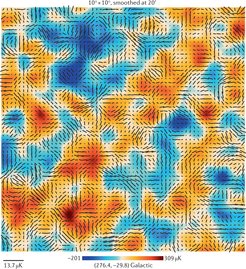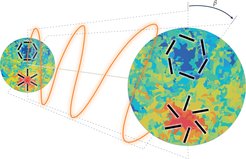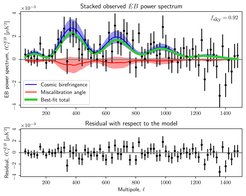New analysis strengthens the hint of new physics in polarized radiation from the early Universe
In 2020, a tantalizing hint of new physics violating “parity symmetry” was found in polarization data of the cosmic microwave background obtained with the Planck satellite at high frequencies. Based on the Planck data and a simplified assumption about the impact of the polarized dust emission in the Milky Way, the scientists reported a violation of the symmetry of the laws of physics under inversion of spatial coordinates with 99.2% confidence level. An international team led by MPA director Eiichiro Komatsu has now improved the analysis method. By considering the dust emission explicitly and using more data from not only Planck but also from WMAP the astrophysicists measured the parity-violating signal with 99.987% confidence level. If this should be confirmed in the future as a genuine cosmological signal, it would have profound implications for the fundamental physics behind dark matter, dark energy, and quantum gravity.

Photons of the cosmic microwave background (CMB), the afterglow of the primordial fireball Universe, are linearly polarized (Figure 1). This pattern can be used to search for new physics violating “parity symmetry” – the symmetry of the laws of physics under an inversion of spatial coordinates. For example, electromagnetism works the same way whether one is in the original system or in a mirrored system with all spatial coordinates flipped. A violation of parity symmetry has only been observed in the weak interaction of the standard model of elementary particles and fields – so far. Can the Universe also violate parity symmetry?
The current cosmological model requires new physics beyond the standard model, such as dark matter and dark energy. These may be made of “pseudoscalar fields”, whose signs change under an inversion of the spatial coordinates. In particle physics, the concept of a pseudoscalar sounds familiar. For example, the particle ‘pion’ is a pseudoscalar, and a neutral pion decays into two photons via a parity-violating interaction in the standard model. This interaction can also rotate the plane of linear polarization of photons.
If the potential new pseudoscalars responsible for dark matter and dark energy interact with photons in a similar fashion, the plane of CMB polarization should have rotated as the CMB photons have been traveling for more than 13 billion years (Figure 2). This phenomenon is called “cosmic birefringence” because it resembles birefringence of photons in a crystal. Space filled with pseudoscalar dark matter and dark energy behaves as if it were a birefringent material! Discovery of cosmic birefringence therefore has profound implications for the fundamental physics behind dark matter, dark energy, and even quantum gravity.

The pattern of linear polarization can be decomposed into eigenstates of parity, called E and B modes (see also Fig. 2) . The E modes do not change sign under inversion of the spatial coordinates, whereas the B modes do. The cross-correlation between the two fields, the so-called “EB correlation”, vanishes if parity symmetry is respected. Therefore, one can search for new physics violating parity symmetry by measuring the EB correlation of the CMB. The previous analysis of the EB correlation in the Planck satellite’s polarization data revealed a tantalizing hint of cosmic birefringence with 99.2% confidence level (see this 2020 MPA Press Release), finding that the plane of linear polarization of the CMB was rotated by an angle β = 0.35 ± 0.14 degrees. This result was based on the Planck satellite’s high-frequency instrument (HFI) data from the Public Release 3 at frequencies higher than 100 GHz.

Now, the international team led by MPA director Eiichiro Komatsu used more CMB data, including the latest reprocessing of the Planck HFI data from Public Release 4 as well as low-frequency data from Planck’s low-frequency instrument (LFI) and WMAP at frequencies lower than 100 GHz. The combined dataset covers a wide range of frequencies from 23 to 353 GHz. The team also improved the analysis method by considering how interstellar dust grains in the Milky Way might impact the EB correlation of the polarization. They found an improved result, β = 0.34 ± 0.09 degrees, which excludes β=0 at 99.987% confidence level. The observed EB correlation is shown in Figure 3. The measured angle β is independent of frequencies and robust against the fraction of sky used for the analysis.
Although suggestive, a greater statistical significance, or a confidence level of 99.99995%, is required to claim a discovery of new physics. This could be achieved in the near future through ongoing and future CMB experiments around the world.














